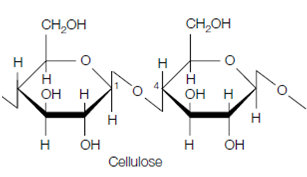Cellulose:
Cellulose is an unbranched polysaccharide of glucose units linked through β1-4 bonds (Fig). Unlike glycogen where the α1-4 linkages lead

Figure: The repeating unit of cellulose showing the β1-4 linkage.
conformation of the polysaccharide, the linkage among glucose residues in cellulose creates extremely long straight chains which are arranged together in fibrils. In the plant cell walls cellulose fibrils are embedded in and cross-linked to a matrix of other polysaccharides. In the wood, this matrix also holds lignin, a difficult polymer of phenolic residues. This composite has a very high tensile strength. Mammals, involving humans, lack enzymes capable of digesting the β1-4 linkages of cellulose and so cannot digest plant cell walls.
Moreover, some bacteria produce cellulases, enzymes which degrade cellulose. Ruminant animals like as cattle have cellulase-producing bacteria in their digestive tracts and so can digest cellulose. Additionally, some protozoa and fungi produce and secrete cellulase.